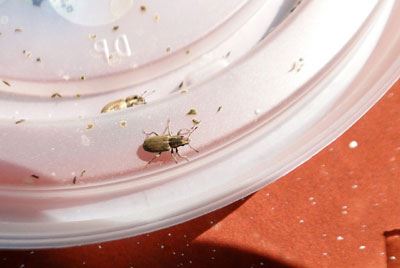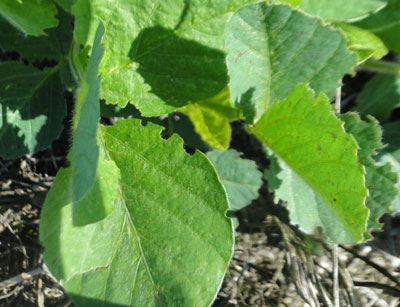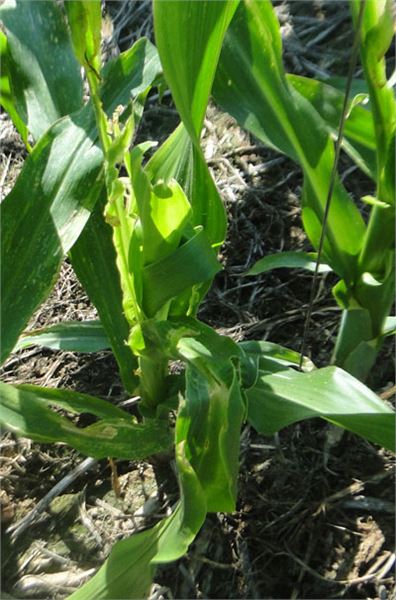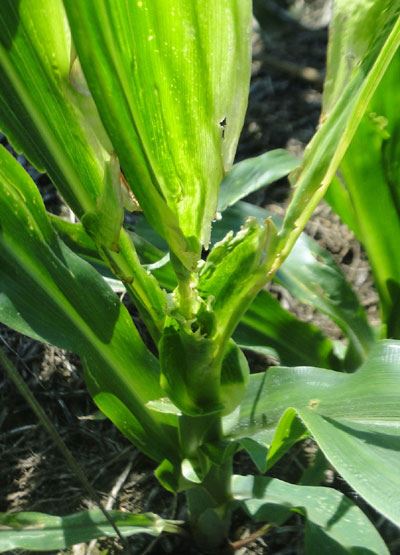|
New Weevil Gnawing At Arkansas Soybeans
MARVELL, ARK.
Arkansas soybean growers are facing a new enemy – the pea weevil – an insect that hitched a ride from Europe in a legume used as a cover crop.
So far, the pea weevil’s presence is limited to just a few fields south of Marvell in Phillips County where Austrian winter field peas had been used as a winter cover crop. Farmers use cover crops to prevent erosion, hold moisture and add nutrients to the soil. The field peas, being legumes, help add nitrogen to the soil, thanks to a friendly bacteria living in the plant roots that fix nitrogen from the atmosphere.

Pea weevil as seen on a take-out drink lid. This pest has been newly confirmed in Arkansas,
found in fields in Phillips Co. Taken June 2014.
photos by Robert Goodson
The pea weevils have also been found in Louisiana and Washington State. In all three instances, “this pest situation is strictly related to this cover crop,” said Gus Lorenz, extension entomologist with the University of Arkansas System Division of Agriculture. “We’re introducing a problem with the cover crops.”
“It appears that the weevil is a legume feeder,” he said. “The immature form feeds on the nitrogen fixing nodules in the soybean roots.”
When the cover crop dies back and soybeans grow up through the residue, the soybeans – also a legume – become the weevil’s target. As adults, the weevils feed on the soybean leaves, leaving a scalloped pattern.
“It looks like you took some pinking shears and went around the edge of the leaf,” said Robert Goodson, Phillips County extension agent for the University of Arkansas System Division of Agriculture. “It’s a very distinct feeding pattern.”

Pea weevil feeding gives soybean leaves a distinct scalloped edge. Taken June 2014 in Phillips Co, Arkansas.
The quarter-inch brown weevils have proven to be very hard to control, Lorenz said.
“As many as you see on the leaf, if you dig down into the cover crop
residue, there’s a ton more of them,” he said. When a farmer applies an
insecticide, it kills the exposed weevils on the plant, “and more come
up and you have to spray again. It may take two or three applications or
more to get them under control.”
Goodson said that, “right now,
we’re working with the farmers to find the right control product and
application timing to work on this insect. We’re talking about a product
that has a little more residual action and trying to time the
applications for when the weevils are out feeding and not under the
residue refuge.”
Bevy of brown stinkbugs
The cover crop has created a second problem for area corn growers.
“Evidently, the winter field peas attract brown stinkbugs, so you get
this big population under the cover crops and when farmers plant corn
into it, the stinkbugs start feeding on the corn,” Lorenz said.
The brown stinkbugs are not a new problem for Arkansas, but this is the
first time producers have seen this many this early in the season.
“When they start feeding on seedling corn, they can kill it or severely
stunt it,” Lorenz said, adding that the feeding pattern is also very
distinct.
“What you get is this progression. They’ll start on one
plant in the row, kill it, then move on to the next one and severely
stunt it,” he said. “Then they’ll start on the next one and the damage
will be pretty bad, then the next one moderately bad.”
Corn that survives will see its ears targeted, sometimes damaged in such a way that the ears will curve, like cow horns.


Example of brown stinkbug damage in corn in Phillips Co., Arkansas, taken June 2014.
U of Arkansas System Division of Agriculture
The producers began seeing problems in corn last year, Lorenz said. “In some areas, the producer cut 170 bushels per acre, and in some spots, zero.”
By the time the ears appear, the farmer may have had to make three or four insecticide applications for stinkbugs.
“You go across or down the road into where the farmer didn’t use the field peas as a cover crop and there’s no damage,” Lorenz said. “Cover crops have advantages, but these producers are paying a big price.” ∆
|
|